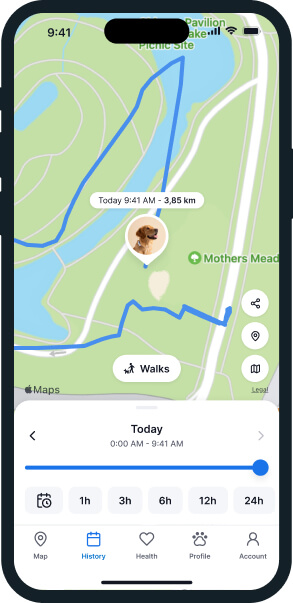 Approved by Dr. Dwight Alleyne, DVM
Approved by Dr. Dwight Alleyne, DVM Dog Pollen Allergy: Dealing With The Springtime Sniffles
The birds are singing, the bees are buzzing, the flowers are blooming - your dog is...sniffling? Here's everything you wanted to know about dog pollen allergies - and how monitoring your buddy's location can actually help you prevent one!

Just like us, dogs can suffer from a wide range of allergies. Including to fleas, food, and other allergens in your environment…like pollen. But how does a dog pollen allergy even look? And how do you treat your poor dog when they’ve got a case of the spring-time sniffles? Let’s dive right into the signs and symptoms – and where a smart dog tracker can help.
Key Takeaways
Unlike humans, a dog’s pollen allergy usually affects their skin, making them excessively itchy. You’ll notice them rubbing, gnawing, or licking their paws, groin, ears, or muzzle a lot.
You can prevent a dog pollen allergy by avoiding walking them when pollen counts are highest (early morning or late afternoon.) Wipe their paws after coming inside, and talk to your vet about medicine, special shampoos, or even a long-term therapy to reduce their sensitivity.
A Tractive smart dog tracker can help you track your dog’s movements to find out exactly where the pollen hotspots are in your neighborhood. So you can either avoid these areas or take steps to treat it (like if it’s your lawn.)

Always know your buddy is healthy & safe
Read more- Can dogs be allergic to pollen?
- Where might my dog run into pollen?
- Dog pollen allergy symptoms
- When is the worst time for dog pollen allergies?
- Which breeds are most at risk of dog pollen allergy?
- Which areas might be more likely to have pollen?
- How to treat pollen allergy in dogs
- How to prevent pollen allergies in dogs
- How a smart dog tracker can help
Can dogs be allergic to pollen?
Yes! Just like you, your dog can have seasonal allergies. Spring, summer and autumn are the seasons when allergens such as pollen are most likely to affect your dog.1 Dogs might come into direct contact with pollen simply by touching pollen-packed plants with their face or feet. Or they could also simply inhale pollen that is floating in the air.
Either way, a pollen allergy – both in dogs and humans – is an overactive immune system’s reaction to the stuff. Your dog’s mast cells start working overtime to get rid of the allergens. Unfortunately, these mast cells also release biochemicals including histamine – which might lead to swelling, redness, and excessive itching.2
Seasonal allergies, also known as hay fever, can occur in humans and dogs alike. Hay fever in dogs is an allergic reaction in the dog’s body as a response to pollen in the air.3 But on the bright side, pollen allergy or hay fever in dogs is much less common than other types of dog allergies, such as flea and dust allergies.
Where might my dog run into pollen?
Pollen is a substance found inside the flowers of grasses, trees, and weeds. This fine, powdery material is an essential part of the fertilization and reproduction of plants (a.k.a. pollination). Pollen is naturally spread by insects or wind.4 Corn, oat, and ragweed are common pollens that can lead to allergies in dogs.
⚠️ If your dog likes to sniff flowers, explore your backyard, or wander around the neighborhood – chances are that they’ll come in direct contact with pollen. When us humans develop an allergic reaction to pollen, we call it a hay fever. It’s this same condition that can affect our furry friends too. That’s why it makes sense to figure out what spots in your neighorhood your dog might be coming in contact with it.

Follow your dog anywhere
Get real-time location information, wherever they go. And find out when they try to make an escape, or just when they go somewhere they shouldn’t, with Virtual Fences.
Dog pollen allergy symptoms
In dogs, a pollen allergy usually affects the skin. So if you notice your dog itching, gnawing or rubbing certain parts of their body like the paws, legs, groin, ears or muzzle, it may be a dog pollen allergy.
⚠️ Just keep in mind, if your dog displays any of the symptoms below, they could also be suffering from another – more serious – medical condition. (Especially if it’s accompanied by concerning symptoms like lethargy or a loss of energy.) So talk to your vet before diagnosing hay fever in your dog. Watch out for signs like:
- Red nose
- Hives
- Itchy skin
- Watery eyes
- Rubbing against furniture or carpets
- Excessive rubbing or licking of affected areas
- Hair loss
- Inflamed patches of skin
- Swollen, itchy paws (which they might lick excessively)
- Sneezing or reverse sneezing
- Ear infections
- Sleepiness5
- Runny nose (including a clear nasal discharge)
- Loss of fur
- Diarrhea
- Vomiting
Pay attention to your dog’s behavior during pollen season. Keep an eye out for any of these symptoms and talk to your vet if you are unsure about your dog’s health.
When is the worst time for dog pollen allergies?
Pollen allergy season is at its peak in spring and summer, but can last until the beginning of autumn. This is due to the fact that pollen comes mostly from grass, weeds, flowers or trees. Tree pollen season usually starts earlier in the year. Grass pollen season gets heavier towards summer. Some scientists report that rising temperatures are leading to more pollen production – that could mean more severe allergy seasons in the future.5
⚠️ Which, as you’re letting your dog outdoors more often, means they’re more likely to pick up something infectious.
Which breeds are most at risk of dog pollen allergy?
According to various studies, dog pollen allergy doesn’t occur in the first year of life. For unknown reasons, it also seems to affect more female dogs than male dogs. Still, while all dogs can suffer from a pollen allergy, some breeds are more at risk than others to this type of allergy. These include:
- Pugs
- German Shepherds
- English and French Bulldogs
- Shar Pei
- Labradors
- Golden Retrievers
- Setters
- Terriers6
- Boxers
- Dalmatians
- Schnauzers
- Cocker Spaniels
- Bichon Frise
This list is not exhaustive, and nearly any dog (breed) could suffer from a dog pollen allergy. Dog pollen allergy is one of the most common types of pet allergies.
Which areas might be more likely to have pollen?
Given its size, the US alone includes a ton of spots that are more likely to be “allergy zones” – while others might be less so. Here are a couple of them:
| High-pollen US states | Low-pollen US states |
| Kansas | Utah |
| Texas | Arizona |
| Missouri | Colorado |
| Iowa | California |
| Oklahoma | Washington |
| Pennsylvania | New York |
| Florida | Ohio |
| South Carolina | Michigan |
| North Carolina | New Mexico |
💡So if you’re planning on moving states or vacationing across them with your dog, keep an eye out for its pollen count this spring – and plan ahead how you’re going to prevent and/or treat it.
How to treat pollen allergy in dogs
Your vet might begin with running some tests to figure out what’s causing your dog’s symptoms in the first place. This might include a thorough physical examination to rule out fleas, ticks, or mites. Besides, they might also recommend intradermal allergy testing, or shaving a patch of your dog’s fur to see how their skin reacts to common local allergens. Or blood tests, to look out for antibodies, like histamines.
Based on how severe your dog’s allergy is, your vet might then recommend:
- Medication & supplements
Like antihistamines or other over-the-counter medications for mild allergies. For more serious allergies, your vet might prescribe you special medication. Supplements containing omega fatty acids and other prescription diets can also reduce the severity of allergies. - Special care products
Like face and paw wipes, shampoos or soaps and special brushes. Medicated shampoos can also help reduce skin infections from yeast and bacteria. Similarly, make sure to use a vet-approved option for cleaning out your dog’s ears. (Another part of their body ripe for infections.) Use a dog-friendly ear cleaner like EpiOtic to keep them clean. - Immunotherapy
Which is a long-term therapy to get your dog less sensitive to a specific allergen. Your vet might administer an allergen mix to your dog to reduce or get rid of any symptoms and then repeat the process over time to help their immune system adjust.
How to prevent pollen allergies in dogs
To minimize your dog’s exposure to pollen during the pollen allergy season, try these tips:
- Protect your dog’s fur
Before heading out, use a special spray containing oatmeal and aloe vera to protect your pup’s fur. You could also consider special dog boots to protect your dog’s paws from picking up any pollen or other infectious little critters. (And then spreading them throughout your house.) - Adapt your walking path
Avoid walking in the early morning or late afternoon and stay away from fields and parks where you might run into dandelions, thistles, and ragweed. Keep your dog leashed when passing by pollen-infested areas. - Clean up extra after walks
Remove any pollen that might’ve clung to your dog’s paws with a clean cloth. Use a hypoallergenic grooming wipe that doesn’t include any fragrances. Soaking your dog’s paws in apple cider vinegar can also help remove pollen and other pesky parasites. Just mix 2 parts water with 1 part apple cider vinegar. - Watch out for fleas & ticks
Regular bathtime with a special hypoallergenic shampoo or moisturizing oil can help with irritated skin. Keep an eye out for any dirty or clumped hair. - Clean out your indoor space
Make sure to vacuum your indoor carpets, curtains, and rugs. These can gather dust, mites, and pollen during springtime and summer. Use a dehumidifier to remove indoor moisture and switch up your air filters regularly to prevent airborne allergens from entering through open windows. Likewise, regularly wash your bedding and anywhere else your dog sleeps on. - Avoid letting your dog spend time around damp surfaces
Like your basement or bathrooms. (Else you’ll be dealing with a pretty nasty mold infection on top of pollen allergies!)
How a smart dog tracker can help
Pollen allergies can make your dog miserable, leading to itchy skin, constant paw licking, and redness. Just like with people, managing dog pollen allergies is all about minimizing exposure and recognizing symptoms quickly. A Tractive smart dog tracker can be an excellent tool for both.
Strapped to your dog’s collar, you can now:
Pinpoint where your dog’s running into pollen
From your dog’s Location History & Heatmap, you can figure out your dog’s regular walking routes and backyard hangouts via the Tractive app. The Heatmap will show you the exact areas where your dog spends the most time. If your dog always gets itchier after a visit to a specific grassy field or wooded path, that area is likely a high-pollen “hotspot.” Identifying this allows you to change your walking route or take steps to treat the area (if it’s your lawn).

Else, when you take your dog out, the LIVE tracking allows you to see precisely where they are. If you know certain areas (like a neighbor’s overgrown flower bed or a field of weeds) are likely high in pollen, you can use the tracker to quickly steer your dog away, reducing their contact with the allergen.
Spot potential health issues early
An allergic reaction doesn’t just make your dog scratch; it affects their overall well-being. If the allergy flare-up is severe enough to cause a major, sudden change in their normal activity or sleep patterns, you’ll receive an instant Health Alert. Plus, by monitoring vital signs like heart and respiratory rate, you can help your vet better understand your dog’s condition and come up with an effective treatment plan.
Your furry friend’s health and wellbeing means as much as to us as it does to you. So we’ve made it a priority to only share medically-relevant content on our blog. This post was checked, double-checked, and medically verified by Georgia-based vet, Dr. Dwight Alleyne.

Dr. Dwight Alleyne, DVM
Originally from Long Island, New York, Dr. Alleyne began his career at a no-kill animal shelter before becoming a licensed veterinary technician. He graduated from Cornell University Veterinary College in 2006 and completed an internship at Purdue University. Now practicing in Georgia, Dr. Alleyne specializes in soft tissue surgery and ultrasounds. He also writes pet health articles on his website, “The Animal Doctor Blog” (www.anmldrblog.com).




